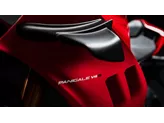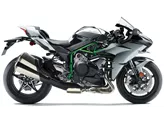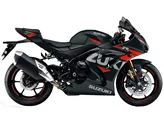Kawasaki Ninja ZX-10R 2015 vs. BMW S 1000 RR 2016

Kawasaki Ninja ZX-10R 2015

BMW S 1000 RR 2016
Vue d’ensemble - Kawasaki Ninja ZX-10R 2015 vs BMW S 1000 RR 2016
The Kawasaki Ninja ZX-10R 2015 and the BMW S 1000 RR 2016 are both high-performance supersport motorcycles that offer impressive power and handling. While they have some similarities in terms of engine type, bore, stroke, compression ratio, cylinders, and displacement, there are also notable differences in their specifications.
Starting with the engine, the Kawasaki Ninja ZX-10R 2015 is equipped with an in-line four-cylinder engine with a bore of 76 mm and a stroke of 55 mm. It produces a maximum power of 200.1 HP and a torque of 114.3 Nm. On the other hand, the BMW S 1000 RR 2016 also features an in-line four-cylinder engine but with a larger bore of 80 mm and a shorter stroke of 49.7 mm. It generates a slightly lower power of 199 HP and a torque of 113 Nm. Both bikes have a compression ratio of 13, ensuring efficient combustion.
In terms of suspension, the Kawasaki Ninja ZX-10R 2015 is equipped with an upside-down telescopic fork at the front, providing excellent stability and control. The BMW S 1000 RR 2016, on the other hand, features a telescopic fork, which also offers good suspension performance. Both bikes have an aluminum frame, ensuring a lightweight and rigid structure.

Kawasaki Ninja ZX-10R 2015
When it comes to braking, both motorcycles feature double disc brakes at the front. The Kawasaki Ninja ZX-10R 2015 utilizes radial petal technology, which enhances braking performance and heat dissipation. The BMW S 1000 RR 2016 also features radial brakes, providing excellent stopping power.
In terms of dimensions and weights, both bikes have a front tire width of 120 mm and a diameter of 17 inches. The rear tire width is also the same at 190 mm with a diameter of 17 inches. However, the BMW S 1000 RR 2016 has a longer wheelbase of 1425 mm compared to the Kawasaki Ninja ZX-10R 2015's 1115 mm. The seat height is slightly higher for the BMW S 1000 RR 2016 at 815 mm compared to the Kawasaki Ninja ZX-10R 2015's 813 mm. The fuel tank capacity is also slightly larger for the BMW S 1000 RR 2016 at 17.5 liters compared to the Kawasaki Ninja ZX-10R 2015's 17 liters.
In terms of strengths, the Kawasaki Ninja ZX-10R 2015 is considered a great basis for a racing bike, thanks to its strong engine in the upper rev range and good chassis. On the other hand, the BMW S 1000 RR 2016 boasts a very powerful engine, a comfortable seating position, and an excellent shift assistant.

BMW S 1000 RR 2016
However, the Kawasaki Ninja ZX-10R 2015 does have some weaknesses. The gear ratio is considered too long, which may affect its acceleration. Additionally, the engine has little power in the lower rev range, making it less responsive at lower speeds. The traction control system also cannot keep up with the systems found in top-tier bikes.
As for the BMW S 1000 RR 2016, it is said to be somewhat sluggish in curves, which may affect its agility and maneuverability.
In conclusion, both the Kawasaki Ninja ZX-10R 2015 and the BMW S 1000 RR 2016 offer impressive performance and features. The Kawasaki Ninja ZX-10R 2015 is known for its strong engine and good chassis, while the BMW S 1000 RR 2016 stands out with its powerful engine and comfortable seating position. However, the Kawasaki Ninja ZX-10R 2015 has some weaknesses in terms of gear ratio and low-end power, while the BMW S 1000 RR 2016 may lack agility in curves. Ultimately, the choice between the two will depend on individual preferences and priorities.
Caractéristiques techniques Kawasaki Ninja ZX-10R 2015 par rapport à BMW S 1000 RR 2016
Avantages et inconvénients en comparaison
Avantages et inconvénients en comparaison
Kawasaki Ninja ZX-10R 2015

Lors du test, la ZX-10R se situait exactement au milieu. Elle n'était pas aussi rapide et radicale que la R1, la Panigale, la BMW et l'Aprilia. Mais elle était aussi plus sportive que la Honda et la Suzuki. Alors que chez Honda et Suzuki, il faudrait des motos entièrement neuves pour se hisser au niveau des leaders, Kawasaki n'aurait qu'à apporter une petite mise à jour à la ZX-10R. Mais les pilotes de ZX-10R satisfaits ne doivent pas désespérer. L'écart avec le peloton de tête est suffisamment faible pour qu'ils puissent le rattraper avec quelques accessoires. Car le ZX-10R a un avantage décisif. Elle est déjà sur le marché depuis longtemps et il y a suffisamment de pièces disponibles avec les informations de réglage nécessaires. Celui qui ne veut pas se lancer dans des expériences peut prendre une Kawasaki et, en quelques manipulations, il sera également en tête.
BMW S 1000 RR 2016

La S 1000 RR est le talent universel parmi les superbikes - on s'assoit dessus et on se sent tout de suite à l'aise. Même si, en comparaison, elle semble un peu nerveuse en termes de châssis et de stabilité. Mais elle transforme cela en une maniabilité agréable et facile et impressionne par son énorme puissance moteur. La roue avant devient en effet particulièrement légère et doit être calmée par l'amortisseur de direction. L'assistant de changement de vitesse pour monter et descendre les rapports est une fonction incroyablement sportive et confortable - elle apporte du calme au châssis et permet de se concentrer pleinement sur la conduite.
Comparaison des prix Prix moyen du marché Kawasaki Ninja ZX-10R vs BMW S 1000 RR
There are a few key differences between a Kawasaki Ninja ZX-10R 2015 and a BMW S 1000 RR 2016. It takes less time to sell a BMW S 1000 RR with 69 days compared to 81 days for the Kawasaki Ninja ZX-10R. Since model year 2005 1000PS.de editors have written 51 reviews for the Kawasaki Ninja ZX-10R and 135 reviews for the BMW S 1000 RR since model year 2010. The first review for the Kawasaki Ninja ZX-10R was published on 1/11/2004 and now has more than 2,900 views. This compares to more than 4,000 views for the first review on BMW S 1000 RR published on 4/16/2008.


















